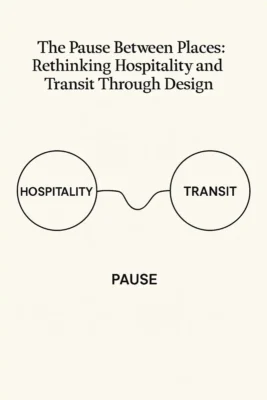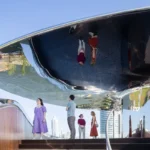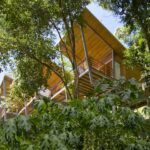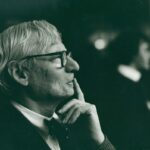Rethinking luxury and transit through design, Pause between places, Ece Cetin architect
The Pause Between Places: Rethinking Luxury and Transit Through Design
28 June 2025
Written by Adrian Welch, architect
How architect Ece Cetin finds rhythm, clarity, and intention in spaces built for both escape and motion.
In an age of constant motion, some spaces ask us to slow down – not through stillness, but through design.
Architectural designer and project manager Ece Cetin understands this ability of design, to arrest deeply. She incorporates this as instinct into her work at Rockwell Group in New York, where she’s played a key role on four ambitious projects that, at first glance, have little in common: a luxury hospitality destination in Dubai, a re-imagining of hospitality in Saudi Arabia, three high-speed rail stations for Brightline West, linking Las Vegas to Southern California, and the renovation of one of Boston’s iconic skyscrapers.
Two are future-facing resorts layered with spectacle and intimacy; the other, a rethinking of transit infrastructure in the vast American desert; the fourth, a re-imagination of a beloved landmark. What unites them is a belief that architecture can do more than guide people through. That it can give them reason to pause, look up, and feel where they are.
A New Kind of Luxury in the Gulf
In a city where architecture often races toward extremes, this new Dubai development takes a more curated approach. The concept blends spatial drama with nostalgic energy, designed to feel immersive but not overwhelming, bold, but never anonymous.
As a key designer involved during the concept and schematic phases, Cetin helped shape the architectural expression of the project’s guest-facing spaces. Her contributions focused on establishing clarity within complexity: translating the project’s layered identity into coherent spatial sequences, refining material transitions, and coordinating detailed interior elements to preserve design intent as the vision matured.
Rather than rely on superficial spectacle, the project builds emotional resonance through carefully composed zones, each with its own mood, rhythm, and relationship to the whole. Cetin’s work has been instrumental in grounding those ambitions in architectural logic, ensuring that the interplay between form, texture, and use remains legible and expressive.
“The interiors strike a balance between the boldness of the unexpected and the warmth of the familiar—seemingly opposing ideas that unfold in quiet harmony,” says Ece Cetin.
In another project imagining a new urban paradigm on the coast of Saudi Arabia, Cetin worked on the early concept development for a series of future-oriented guestroom typologies. These rooms, designed as modular, sensor-rich environments, challenge the traditional boundaries of hospitality by acting as adaptive ecosystems—spaces that not only respond to the rhythms of the guest but actively promote wellbeing, creativity, and rest. Working from speculative user scenarios, Cetin helped shape transformable layouts and atmospheric zoning strategies that allowed each room to shift between functions: sleep, movement, work, and reflection. Whether mapping furniture that could disappear into the ceiling or coordinating lighting systems aligned with circadian rhythms, she approached each spatial condition as both architectural and experiential. In a city imagined to dissolve the line between infrastructure and environment, her design logic provided continuity—ensuring that these rooms remained personal, purposeful, and deeply human.
“Tomorrow’s hospitality isn’t defined by space alone, but how it senses, adapts and elevates guest experience by orchestrating emotion, behavior and wellbeing.” says Ece Cetin.
Stations That Refuse to Disappear
If Dubai’s design asks how people arrive and linger, the Brightline West stations ask how we move and what we feel in the liminal. The three new stations – Rancho Cucamonga, Victor Valley, and Las Vegas – aim to transform regional travel, offering a faster, more sustainable alternative to driving or flying.
But beyond efficiency, these stations were conceived as a counterpoint to the ubiquitous non-space of global transit. In place of the bland, forgettable environments that typify travel today, Cetin and the design team worked to create architecture that encourages awareness. These are not corridors to be endured, passed through, and forgotten. They are places to reorient, to take in light, and to briefly belong.
Cetin contributed to both schematic design and design development phases, helping articulate circulation logic, spatial identity, and the material framework of each station. Her work focused on ensuring that the architecture remained human-scaled and sensorially rich, even as it interfaced with complex systems and infrastructural demands.
“People rarely feel connected to transit spaces—but when design makes room for even a brief pause, it can reframe the whole experience,” she says.
In a setting where people might otherwise be lost in movement, the design offers visual cues, thoughtful alignments, and natural thresholds – small interventions that suggest: you’re here now.
Reimagining an Icon from the Inside Out
In Boston, Cetin was part of the team tasked with reimagining one of the city’s most emblematic structures, the tall glass office tower located in Back Bay. This transformation was not a reinvention of form, but of feeling—rethinking how a modernist glass icon could engage the senses in a more contemporary way. The design concept, titled Reflection, sought to soften the building’s formal clarity with a series of warm, immersive interiors spanning three floors of amenity and communal space. Cetin contributed across multiple zones—from the mezzanine and Sky Lounge to the locker rooms and group exercise studios—where her work focused on establishing spatial coherence and experiential depth. She was particularly involved in the articulation of vertical thresholds, circulation sequences, and material adjacencies, ensuring that the transitions between movement and pause, social and solitary, felt intentional rather than incidental.
“In a building so deeply rooted in the city’s identity, our challenge was to design spaces that felt open and connected—while still offering immersive, self-contained moments of retreat,” she says.
Her renderings and layout studies played a central role in shaping the project’s double-height lounge and wellness facilities, which include a fitness reception, dry vanity area, and a suite of locker and shower rooms. Drawing on her strengths in both architectural and interior detailing, Cetin helped translate the project’s material ambitions—walnut, plaster, travertine, and satin bronze—into legible, inhabitable rhythms. The result is a space that reframes corporate amenity as restorative architecture. Across the office tower, Cetin’s sensitivity to flow, tactility, and spatial punctuation helped give new resonance to a familiar skyline presence. Within its glass envelope, the building now offers a richer interior life—one that reflects, quite literally, how far hospitality-inflected workplace design has come.
Architecture as Pause
Across all 4 projects, Cetin’s design work reflects a rare sensitivity not just to form, but to tempo. Whether shaping the layered hospitality of a desert resort or the flow of a public station, her approach centers attention: on what it means to arrive, to wait, to notice.
Her architecture doesn’t shout for attention. It holds space for it. And in a world conditioned to rush past everything, that kind of design is not merely thoughtful. It is radical.
About the Designer
Ece Cetin is a Turkish architectural designer based in New York. She holds a Master of Advanced Architectural Design from Columbia University GSAPP and dual degrees in Architecture and Fine Arts from the Rhode Island School of Design. Currently at Rockwell Group, her work spans hospitality, cultural, and infrastructural projects, with a focus on narrative clarity, spatial precision, and the human scale of large-scale design.
Ece Cetin Columbia GSAPP graduation:

Comments on this guide to Rethinking luxury hospitality and transit through design, Pause between places article are welcome.
Architecture
Recently added Building posts
How biophilic architecture is bringing nature indoors
Managing outdoor space maintenance in school settings
Sustainable property management
Workspace Building Design
Comments / photos for the Rethinking luxury hospitality and transit through design, Pause between places page welcome.






